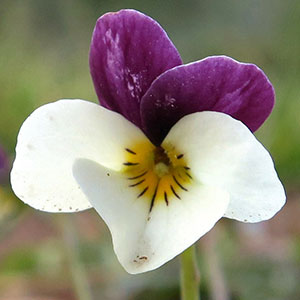Viola hallii
Viola orbiculata
Hall's violet, Oregon violet, wild pansy
darkwoods violet, evergreen yellow violet, round-leaf or round-leaf wood or western round-leaf or evergreen violet, round-leaf violet, violette orbiculaire
1–3, decumbent or ascending to erect, ca. 1/2 subterranean, glabrous, clustered on single, short, vertical, deep-seated caudex.
1–5, prostrate or erect, leafy proximally and distally, usually glabrous, from current and/or previous year’s growth, on usually vertical, fleshy rhizome.
basal and cauline;
basal: 1–4, palmately compound, ± 2-ternate or 3-ternate, leaflets 3;
stipules adnate to petiole, forming 2 linear-lanceolate wings, unlobed, margins entire, apex of each wing free, acute;
petiole 5–8 cm, glabrous;
blade ovate to deltate, 2.8–6 × 2.6–6.5 cm, ± coriaceous, base tapered, ultimate lobes narrowly elliptic, lanceolate, or oblanceolate, 1–7 mm wide, margins entire, ciliate or eciliate, apex acute, mucronulate, surfaces glabrous;
cauline similar to basal except: stipules usually lanceolate, sometimes broadly ovate, ± leaflike, margins toothed;
petiole 1.3–6 cm;
blade 2–4.8 × 1.2–5.5 cm.
basal and cauline;
basal: 3–11;
stipules deltate to lanceolate, margins entire, apex acute to acuminate;
petiole 2.1–10.5 cm, glabrous or pubescent;
blade usually orbiculate to broadly ovate, sometimes reniform, 1.4–5.3 × 1.4–5.3 cm, base cordate, margins crenate to serrulate-crenulate, eciliate or sparingly ciliate, apex usually obtuse, rarely acute, abaxial surface usually glabrous, adaxial surface sparsely pubescent;
cauline similar to basal except: stipules lanceolate to ovate, margins usually entire, ciliate;
petiole 0.7–1 cm, glabrous or pubescent;
blade 1.2–2 × 1.1–1.4 cm.
2.5–11 cm, glabrous.
2.7–5.6 cm, glabrous.
sepals lanceolate to ovate, margins ciliate, auricles 0.5–1 mm;
petals: upper 2 almost black abaxially, dark reddish violet adaxially, lower 3 pale yellow, cream, or ± white, lateral 2 bearded, with deep yellow to orange patch basally, dark reddish violet-veined, lowest with deep yellow to orange patch basally, dark reddish violet-veined, 5–18 mm, spur yellow, gibbous, 0.5–2 mm;
style head bearded; cleistogamous flowers absent.
sepals narrow to broadly lanceolate, margins eciliate, auricles 0.5–1.5 mm;
upper 2 and lateral 2 petals deep lemon-yellow on both surfaces, lower 3 and sometimes upper 2 brownish purple-veined, lateral 2 usually bearded, lowest 8–17 mm, spur usually yellow, sometimes whitish, gibbous, 1.5–2.5 mm;
style head bearded; cleistogamous flowers axillary.
ellipsoid, 4–12 mm, glabrous.
ellipsoid, 6–8 mm, glabrous.
light brown, shiny, 3.2–3.5 mm.
light to dark brown, sometimes mottled with white, 2–2.3 mm.
= 60, 72.
= 24.
Viola hallii
Viola orbiculata
Viola hallii was discovered on the grounds of Willamette University in Salem, Oregon, by Elihu Hall, a professor at that institution (V. B. Baird 1942). Leaves of V. hallii are similar to V. beckwithii.
(Discussion copyrighted by Flora of North America; reprinted with permission.)
During winter, the basal leaves of Viola orbiculata are appressed to the ground under the weight of snow. The leaves overwinter and are often partly or entirely green after the snow has melted. Mature plants possess 3–11 basal leaves, some derived from previous years and others from the current year’s growth. Occasional plants are found with short, thin stems rooted at the tip and producing a rosette of leaves and stems, showing the close relationship with V. sempervirens.
(Discussion copyrighted by Flora of North America; reprinted with permission.)


